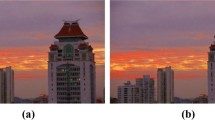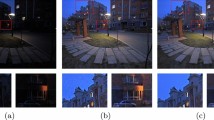Abstract
Insufficient illumination causes poor discernibility of visuals captured under low light environment. Often, computer vision algorithms designed to process visuals taken under normal light struggle to handle visuals with low visibility. The present work proposes a low rank approximation (LRA) based optimization model in producing the brightness enhanced version from the input low light image. The work adopts \(l_{1/2}\) nuclear norm and sparsity minimization combined with total variation (TV) regularization to estimate the illumination map required to reconstruct the clear image. The \(l_{1/2}\) nuclear norm serves primarily for smoothing the coarse illumination map, while TV regularization helps to preserve the prominent edge information. Additionally, \(l_{1/2}\) regularization aids to retain the sparse structural details. The intelligence of the proposed method is bounded in the efficient formulation of a unified optimization model for the estimation of illumination map with low rank and sparsity concepts which is never reported in the direction of low light image enhancement. Furthermore, extensive experiments confirm that the proposed method outperforms the current state of art methods in low light image enhancement.




Similar content being viewed by others
References
Arici T, Dikbas S, Altunbasak Y (2009) A histogram modification framework and its application for image contrast enhancement. IEEE Trans Image Process 18(9):1921–1935
Boyd S, Parikh N, Chu E, Peleato B, Eckstein J et al (2011) Distributed optimization and statistical learning via the alternating direction method of multipliers. Found Trends Mach Learn 3(1):1–122
Bras NB, Bioucas-Dias J, Martins RC, Serra AC (2012) An alternating direction algorithm for total variation reconstruction of distributed parameters. IEEE Trans Image Process 21(6):3004–3016
Cai JF, Candès EJ, Shen Z (2010) A singular value thresholding algorithm for Matrix completion. SIAM J Optim 20(4):1956–1982
Celik T (2014) Spatial entropy-based global and local image contrast enhancement. IEEE Trans Image Process 23(12):5298–5308
Chen C, Chen Q, Xu J, Koltun V (2018) Learning to see in the dark. In: Proceedings of the IEEE Conference on Computer Vision and Pattern Recognition, pp 3291–3300
Chen G, Li G, Liu Y, Zhang XP, Zhang L (2017) Sar image despeckling by combination of fractional-order total variation and nonlocal low rank regularization. In: 2017 IEEE International Conference on Image Processing (ICIP), IEEE, pp 3210–3214
Dang-Nguyen DT, Pasquini C, Conotter V, Boato G (2015) Raise: a raw images dataset for digital image forensics. In: Proceedings of the 6th ACM Multimedia Systems Conference, pp 219–224
Fu X, Zeng D, Huang Y, Liao Y, Ding X, Paisley J (2016a) A fusion-based enhancing method for weakly illuminated images. Signal Process 129:82–96
Fu X, Zeng D, Huang Y, Zhang XP, Ding X (2016b) A weighted variational model for simultaneous reflectance and illumination estimation. In: Proceedings of the IEEE Conference on Computer Vision and Pattern Recognition, pp 2782–2790
Guo X, Li Y, Ling H (2016) Lime: low-light image enhancement via illumination map estimation. IEEE Trans Image Process 26(2):982–993
Hautière N, Tarel JP, Aubert D, Dumont E (2008) Blind contrast enhancement assessment by gradient ratioing at visible edges. Image Anal Stereol 27(2):87–95
Ibrahim H, Kong NSP (2007) Brightness preserving dynamic histogram equalization for image contrast enhancement. IEEE Trans Consum Electron 53(4):1752–1758
Jia S, Zhang X, Li Q (2015) Spectral-spatial hyperspectral image classification using \(l_{1/2}\) regularized low-rank representation and sparse representation-based graph cuts. IEEE J Sel Top Appl Earth Obs Remote Sens 8(6):2473–2484
Kim YT (1997) Contrast enhancement using brightness preserving bi-histogram equalization. IEEE Trans Consum Electron 43(1):1–8
Kim JH, Jang WD, Sim JY, Kim CS (2013) Optimized contrast enhancement for real-time image and video dehazing. J Vis Commun Image Represent 24(3):410–425
Lee S (2007) An efficient content-based image enhancement in the compressed domain using Retinex theory. IEEE Trans Circuits Syst Video Technol 17(2):199–213
Lee C, Lee C, Lee YY, Kim CS (2011) Power-constrained contrast enhancement for emissive displays based on histogram equalization. IEEE Trans Image Process 21(1):80–93
Li C, Yin W, Jiang H, Zhang Y (2013) An efficient augmented Lagrangian method with applications to total variation minimization. Comput Optim Appl 56(3):507–530
Li C, Guo J, Porikli F, Pang Y (2018) Lightennet: a convolutional neural network for weakly illuminated image enhancement. Pattern Recogn Lett 104:15–22
Liu S, Zhang Y (2019) Detail-preserving underexposed image enhancement via optimal weighted multi-exposure fusion. IEEE Trans Consum Electron 65(3):303–311
Liu S, Hu Q, Li P, Zhao J, Liu M, Zhu Z (2018a) Speckle suppression based on weighted nuclear norm minimization and Grey theory. IEEE Trans Geosci Remote Sens 57(5):2700–2708
Liu S, Hu Q, Li P, Zhao J, Wang C, Zhu Z (2018b) Speckle suppression based on sparse representation with non-local priors. Remote Sens 10(3):439
Lore KG, Akintayo A, Sarkar S (2017) Llnet: a deep autoencoder approach to natural low-light image enhancement. Pattern Recogn 61:650–662
Madathil B, George SN (2018a) DCT based weighted adaptive multi-linear data completion and denoising. Neurocomputing 318:120–136
Madathil B, George SN (2018b) Twist tensor total variation regularized-reweighted nuclear norm based tensor completion for video missing area recovery. Inform Sci 423:376–397
Park S, Yu S, Kim M, Park K, Paik J (2018) Dual autoencoder network for Retinex-based low-light image enhancement. IEEE Access 6:22084–22093
Petro AB, Sbert C, Morel JM (2014) Multiscale Retinex. Image Process On Line, pp 71–88
Ren Y, Ying Z, Li TH, Li G (2019) Lecarm: low-light image enhancement using the camera response model. IEEE Trans Circuits Syst Video Technol 29(4):968–981
Sakurai M, Kiriyama S, Goto T, Hirano S (2011) Fast algorithm for total variation minimization. In: 2011 18th IEEE International Conference on Image Processing, IEEE, pp 1461–1464
Saleem A, Beghdadi A, Boashash B (2012) Image fusion-based contrast enhancement. EURASIP J Image Video Process 1:10
Sang NT, Van An H, My NVT, Lung VD (2016) Context-based fusion and enrichment by adapted coefficients for image enhancement purposes. In: 2016 International Conference on Electronics, Information, and Communications (ICEIC), IEEE, pp 1–4
Shi Y, Wu X, Zhu M (2019) Low-light image enhancement algorithm based on retinex and generative adversarial network. arXiv preprint arXiv:190606027
Strong D, Chan T (2003) Edge-preserving and scale-dependent properties of total variation regularization. Inverse Probl 19(6):S165
Subramani B, Veluchamy M (2020) Quadrant dynamic clipped histogram equalization with gamma correction for color image enhancement. Color Res Appl 45:644–655
Tang L, Luo L, Long B, Chen D, Zeng J (2019) An infrared image enhancement method based on power function histogram equalization. In: 2019 3rd International Conference on Electronic Information Technology and Computer Engineering (EITCE), IEEE, pp 949–952
Tom AJ, George SN (2019) A three-way optimization technique for noise robust moving object detection using tensor low-rank approximation, l1/2, and ttv regularizations. IEEE Trans Cybern
Wang C, Ye Z (2005) Brightness preserving histogram equalization with maximum entropy: a variational perspective. IEEE Trans Consum Electron 51(4):1326–1334
Wang S, Zheng J, Hu HM, Li B (2013a) Naturalness preserved enhancement algorithm for non-uniform illumination images. IEEE Trans Image Process 22(9):3538–3548
Wang S, Zheng J, Hu HM, Li B (2013b) Naturalness preserved enhancement algorithm for non-uniform illumination images. IEEE Trans Image Process 22(9):3538–3548
Wang S, Ma K, Yeganeh H, Wang Z, Lin W (2015) A patch-structure representation method for quality assessment of contrast changed images. IEEE Signal Process Lett 22(12):2387–2390
Wang YF, Liu HM, Fu ZW (2019) Low-light image enhancement via the absorption light scattering model. IEEE Trans Image Process 28(11):5679–5690
Wang W, Wei C, Yang W, Liu J (2018) Gladnet: Low-light enhancement network with global awareness. In: 2018 13th IEEE International Conference on Automatic Face & Gesture Recognition (FG 2018), IEEE, pp 751–755
Xiaoying Fang, Jingao Liu, Wenquan Gu, Yiwen Tang (2011) A method to improve the image enhancement result based on image fusion. In: 2011 International Conference on Multimedia Technology, pp 55–58
Xu Z, Chang X, Xu F, Zhang H (2012) \(l\)\(_{1/2}\) regularization: a thresholding representation theory and a fast solver. IEEE Trans Neural Netw Learn Syst 23(7):1013–1027
Xu H, Zhai G, Wu X, Yang X (2014) Generalized equalization model for image enhancement. IEEE Trans Multimed 16(1):68–82. https://doi.org/10.1109/TMM.2013.2283453
Xue W, Zhang L, Mou X, Bovik AC (2013) Gradient magnitude similarity deviation: a highly efficient perceptual image quality index. IEEE Trans Image Process 23(2):684–695
Xu L, Lu C, Xu Y, Jia J (2011) Image smoothing via l 0 gradient minimization. In: Proceedings of the 2011 SIGGRAPH Asia Conference, pp 1–12
Yang J, Jiang X, Pan C, Liu CL (2016) Enhancement of low light level images with coupled dictionary learning. In: 2016 23rd International Conference on Pattern Recognition (ICPR), IEEE, pp 751–756
Ying Z, Li G, Gao W (2017) A bio-inspired multi-exposure fusion framework for low-light image enhancement. arXiv preprint arXiv:171100591
Yu X, Xiao C, Deng M, Peng L (2011) A classification algorithm to distinguish image as haze or non-haze. In: 2011 Sixth International Conference on Image and Graphics, IEEE, pp 286–289
Zeng J, Lin S, Wang Y, Xu Z (2014) \(l\)\(_{1/2}\) regularization: convergence of iterative half thresholding algorithm. IEEE Trans Signal Process 62(9):2317–2329
Zhao W, Lu H, Wang D (2018) Multisensor image fusion and enhancement in spectral total variation domain. IEEE Trans Multimed 20(4):866–879
Zhu L, Fu CW, Jin Y, Wei M, Qin J, Heng PA (2016) Non-local sparse and low-rank regularization for structure-preserving image smoothing. Comput Graph Forum 35:217–226
Zhu L, Hao Y, Song Y (2017) \(l_{1/2}\) norm and spatial continuity regularized low-rank approximation for moving object detection in dynamic background. IEEE Signal Process Lett 25(1):15–19
Author information
Authors and Affiliations
Corresponding author
Ethics declarations
Conflict of interest
The authors declare that this work is original, is not been fully or partly published before and is not currently being considered for publication elsewhere. They also confirm that there are no known conflicts of interest associated with this publication and there has been no significant financial support for this work that could have influenced its outcome.
Additional information
Publisher's Note
Springer Nature remains neutral with regard to jurisdictional claims in published maps and institutional affiliations.
Rights and permissions
About this article
Cite this article
Baiju, P.S., George, S.N. \(l_{1/2}\) regularized joint low rank and sparse recovery technique for illumination map estimation in low light image enhancement. J Ambient Intell Human Comput 13, 903–920 (2022). https://doi.org/10.1007/s12652-021-02947-x
Received:
Accepted:
Published:
Issue Date:
DOI: https://doi.org/10.1007/s12652-021-02947-x




